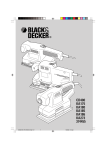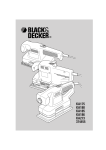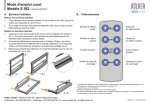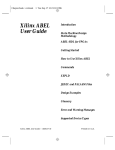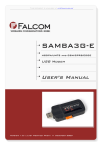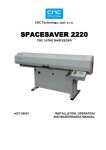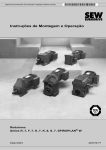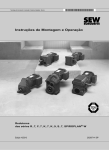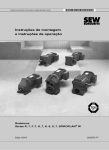Download Black & Decker KA273 Instruction manual
Transcript
® www.blackanddecker.com.au CD400A-XE KA196-XE KA273-XE KA196E-XE Australia New Zealand CD400A-XE 1 4 2 3 KA196-XE/KA196E-XE 1 5 KA273-XE 1 A 2 4 3 2 4 3 2 3 B 4 4 3 3 4 C D 4 3 2 E 6 8 7 5 G F 10 11 9 KA196-XE/KA196E-XE CD400A-XE 1 KA273-XE 1 H 4 1 I J ENGLISH SANDER CD400A-XE/KA196-XE/KA196E-XE/KA273-XE INTENDED USE Your Black & Decker sander CD400A/KA196 / KA196E/KA273 has been designed for sanding wood, metal, plastics and painted surfaces. This tool is intended for consumer use only. SAFETY INSTRUCTIONS : c. d. The following symbols are shown on the tool: @ Warning! To reduce the risk of injury, the user must read the instruction manual. General power tool safety warnings Warning! Read all safety warnings and all instructions. Failure to follow the warnings and instructions listed below may result in electric shock, fire and/or serious injury. Save all warnings and instructions for future reference. The term "power tool" in all of the warnings listed below refers to your mains operated (corded) power tool or battery operated (cordless) power tool. 1. Work area safety a. Keep work area clean and well lit. Cluttered or dark areas invite accidents. b. Do not operate power tools in explosive atmospheres, such as in the presence of flammable liquids, gases or dust. Power tools create sparks which may ignite the dust or fumes. c. Keep children and bystanders away while operating a power tool. Distractions can cause you to lose control. 2. Electrical safety a. Power tool plugs must match the outlet. Never modify the plug in any way. Do not use any adapter plugs with earthed (grounded) power tools. Unmodified plugs and matching outlets will reduce risk of electric shock. b. Avoid body contact with earthed or e. f. grounded surfaces such as pipes, radiators, ranges and refrigerators. There is an increased risk of electric shock if your body is earthed or grounded. Do not expose power tools to rain or wet conditions. Water entering a power tool will increase the risk of electric shock. Do not abuse the cord. Never use the cord for carrying, pulling or unplugging the power tool. Keep cord away from heat, oil, sharp edges or moving parts. Damaged or entangled cords increase the risk of electric shock. When operating a power tool outdoors, use an extension cord suitable for outdoor use. Use of a cord suitable for outdoor use reduces the risk of electric shock. If operating a power tool in a damp location is unavoidable, use a residual current device (RCD) protected supply. Use of an RCD reduces the risk of electric shock. 3. Personal safety a. Stay alert, watch what you are doing and use common sense when operating a power tool. Do not use a power tool while you are tired or under the influence of drugs, alcohol or medication. A moment of inattention while operating power tools may result in serious personal injury. b. Use personal protective equipment. Always wear eye protection. Protective equipment such as dust mask, non-skid safety shoes, hard hat, or hearing protection used for appropriate conditions will reduce personal injuries. c. Prevent unintentional starting. Ensure the switch is in the off-position before connecting to power source and/or battery pack, picking up or carrying the tool. Carrying power tools with your finger on the switch or energising power tools that have the switch on invites accidents. d. Remove any adjusting key or wrench before turning the power tool on. A wrench or a key left attached to a rotating part of the power tool may result in personal injury. e. Do not overreach. Keep proper footing and 5 ENGLISH balance at all times. This enables better control of the power tool in unexpected situations. f. Dress properly. Do not wear loose clothing or jewellery. Keep your hair, clothing and gloves away from moving parts. Loose clothes, jewellery or long hair can be caught in moving parts. g. If devices are provided for the connection of dust extraction and collection facilities, ensure these are connected and properly used. Use of dust collection can reduce dust-related hazards. 4. Power tool use and care a. Do not force the power tool. Use the correct power tool for your application. The correct power tool will do the job better and safer at the rate for which it was designed. b. Do not use the power tool if the switch does not turn it on and off. Any power tool that cannot be controlled with the switch is dangerous and must be repaired. c. Disconnect the plug from the power source and/or the battery pack from the power tool before making any adjustments, changing accessories, or storing power tools. Such preventive safety measures reduce the risk of starting the power tool accidentally. d. Store idle power tools out of the reach of children and do not allow persons unfamiliar with the power tool or these instructions to operate the power tool. Power tools are dangerous in the hands of untrained users. e. Maintain power tools. Check for misalignment or binding of moving parts, breakage of parts and any other condition that may affect the power tools operation. If damaged, have the power tool repaired before use. Many accidents are caused by poorly maintained power tools. f. Keep cutting tools sharp and clean. Properly maintained cutting tools with sharp cutting edges are less likely to bind and are easier to control. g. Use the power tool, accessories and tool bits etc. in accordance with these instructions, taking into account the working conditions and the work to be performed. Use of the power tool for operations different from those intended could result in a hazardous situation. 6 5. Service a. Have your power tool serviced by a qualified repair person using only identical replacement parts. This will ensure that the safety of the power tool is maintained. b. Power to the tool should always be supplied via residual current device with a rated residual current of 30mA or less. Electrical safety This tool is double insulated; therefore no earth wire is required. Always check that the power supply corresponds to the voltage on the rating plate. Additional safety instructions for sanders Always wear a dust mask whenever sanding. Thoroughly remove all dust after sanding. Take special care when sanding paint which is possibly lead based or when sanding some woods and metal which may produce toxic dust: - Wear a dust mask specifically designed for protectiona gainst lead paint dust and fumes and ensure that persons within or entering the work area are also protected. - Do not let children or pregnant women enter the work area. - Do not eat, drink or smoke in the work area. - Dispose of dust particles and any other debris safely. Never use a light socket. Using an extension cable Always use an approved extension cable suitable for the power input of this tool (see technical data). When using a cable reel, always unwind the cable completely. CARTON CONTENTS The carton contains: 1 Sander 1 Sanding sheet 1 Dust adaptor (CD400A-XE/KA196-XE/KA196E-XE) 1 Dustbag (KA273-XE) 1 Instruction manual 1 Parts diagram ENGLISH Carefully unpack all parts. Please note that additional items may be found in the carton, depending on the letter suffix following the catalogue number of your tool. 1. 2. 3. 4. 5. OVERVIEW (fig. A) On/off switch Dust extraction outlet Sanding base Paper clamp lever Variable speed control knob (KA196E-XE) ASSEMBLY Before assembly, make sure that the tool is switched off and unplugged. Fitting sanding sheets (fig. B, C & D) Never use the tool without a sanding sheet or accessory in place. KA196-XE/KA196E-XEMake sure that the tool is switched off and unplugged. Press the sheet firmly and evenly onto the sanding base (3), making sure that the holes in the sheet line up with the holes in the base. CD400A-XE/KA196-XE/KA196E-XEFitting regular sanding sheets Make sure that the tool is switched off and unplugged. Soften the sanding sheet by rubbing its nonabrasive side over the edge of a worktop. Press the paper clamp levers (4) upwards to release them from the retaining grooves and open the paper clamps by pressing them down. Place the sheet onto the sanding base, making sure that the holes in the sheet line up with the holes in the base. Insert the edge of the sanding sheet into the front paper clamp as shown. Press the front paper clamp lever (4) downwards and locate it in the retaining groove. While keeping a slight tension on the sheet, insert the rear edge of the sheet into the rear paper clamp. Press the rear paper clamp lever (4) downwards and locate it in the retaining groove. KA273-XEMake sure that the tool is switched off and unplugged. Soften the sanding sheet by rubbing its nonabrasive side over the edge of a worktop. Operate the paper clamp levers (4) as shown to open the paper clamps. Place the sheet onto the sanding base, making sure that the holes in the sheet line up with the holes in the base. Insert the edge of the sanding sheet into the front paper clamp as shown. Operate the front paper clamp lever (4) to close the front paper clamp. While keeping a slight tension on the sheet, insert the rear edge of the sheet into the rear paper clamp. Operate the rear paper clamp lever (4) to close the rear paper clamp. CD400A-XE/KA196-XE/KA196E-XEConnecting a vacuum cleaner (fig. E) Insert the adaptor (6) into the dust extraction outlet (2). Connect the hose (7) of the vacuum cleaner to the adaptor. KA273-XE Fitting and removing the dustbag (fig. F) To fit the dustbag, slide the cover (8) of the dust extraction outlet backward. Insert the nozzle (9) on the dustbag (10) into the outlet (2) until it is properly located. To remove the dustbag, depress the release catch (11) and pull the dustbag upwards off the outlet. USE Let the tool work at its own pace. Do not overload. 7 ENGLISH KA196E-XE - Variable speed control (fig. G) The variable speed control allows you to adapt the speed of the tool to the workpiece material. Set the control knob (5) to the desired setting. The table below suggests settings for different applications. Application Hardwood (beech) Softwood (pine) Veneer wood Synthetic material Acrylic glass Non-ferrous metal Steel Paint removal Setting 3-5 3-5 2-4 3-4 2-5 2-5 2-5 3-5 Switching on and off (fig. H & I) CD400A-XE/KA273-XE (fig. H) To switch the tool on, slide the on/off switch (1) forward (position 1). To switch the tool off, slide the on/off switch to the rear (position 0). KA196-XE/KA196E-XE (fig. I) To switch the tool on, press the front part I of the on/off switch (1). To switch the tool off, press the rear part O of the on/off switch. KA273-XE - Emptying the dustbag Open the zip fastener. Shake the dustbag to empty the contents. Close the zip fastener. Hints for optimum use Always hold the tool with both hands (fig. J). Do not exert too much pressure on the tool. Regularly check the condition of the sanding sheet. Replace when necessary. Always sand with the grain of the wood. When sanding new layers of paint before applying another layer, use extra fine grit. On very uneven surfaces, or when removing 8 layers of paint, start with a coarse grit. On other surfaces, start with a medium grit. In both cases, gradually change to a fine grit for a smooth finish. Consult your retailer for more information on available accessories. MAINTENANCE Your Black & Decker tool has been designed to operate over a long period of time with a minimum of maintenance. Continuous satisfactory operation depends upon proper tool care and regular cleaning. Before performing any maintenance, switch off and unplug the tool. Regularly clean the ventilation slots in your tool using a soft brush or dry cloth. Regularly clean the motor housing using a damp cloth. Do not use any abrasive or solvent-based cleaner. PROTECTING THE ENVIRONMENT Should you find one day that your tool needs replacement, or if it is of no further use to you, think of the protection of the environment. Black & Decker repair agents will accept old Black & Decker tools and ensure that they are disposed of in an environmentally safe way. Statutory Warranties: Our goods come with guarantees that cannot be excluded under Australian Consumer Law. You are entitled to a replacement or refund for a major failure and compensation for any other loss or damage. You are also entitled to have the goods repaired or replaced if the goods fail to be of acceptable qual-ity and the failure does not amount to a major failure. To claim on the guarantee, you will need to submit proof of purchase to the seller or an authorised repair agent. You can check the location of your nearest authorised repair agent by contacting your ENGLISH local Black & Decker office at the address indicated in this manual. Alternatively, a list of authorised Black & Decker repair agents and full details of our after-sales service and contacts are available on the Internet at: www.2helpU.com Please visit our website www.blackanddecker. com.au to register your new Black & Decker product and to be kept up to date on new products and special offers. Further information on the Black & Decker brand and our range of products is available at www.blackanddecker. com.au Technical data Voltage VAC Power input W Oscillations (no load) min-1 Orbits (no load) min-1 Sanding base surface mm Weight kg CD400A-XE 230 135 22,000 11,000 90 x 187 1.2 KA196-XE 230 135 22,000 11,000 90 x 187 1.3 Voltage VAC Power input W Oscillations (no load) min-1 Orbits (no load) min-1 Sanding base surface mm Weight kg KA196E-XE 230 135 13,000 -22,000 6,500 - 11,000 90 x 187 1.3 KA273-XE 230 250 20,000 10,000 115 x 230 1.8 Level of sound pressure, measured according to EN 50144: CD400A-XE KA196-XE KA273-XE LpA KA196E (sound pressure) dB(A) 85 85 LWA (acoustic power) dB(A) 98 98 Always wear ear protection if the sound pressure exceeds 85 dB(A). Hand/arm weighted vibration value according to EN 50144: CD400A-XE KA19 6-XE KA196E-XE KA273-XE 2.9 m/s2 2.8 m/s2 2.8 m/s2 4.6 m/s2 9 Australia & New Zealand Stanley Black & Decker 82 Taryn Drive, Epping, VIC 3076 Australia Tel.1800 444 224 (Aust) or Tel. 0800 339 258 (NZ) 90589348 06/12












